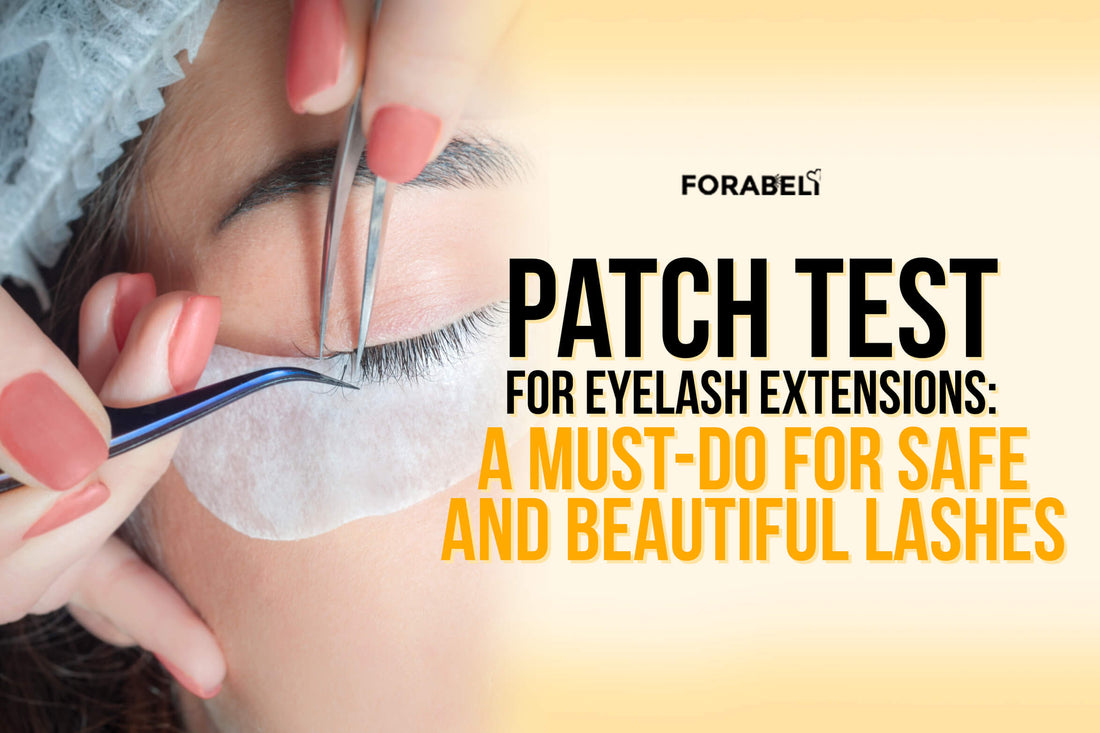
Patch Test for Eyelash Extensions: A Must-Do for Safe and Beautiful Lashes
Share
Oh, the captivating allure of eyelash extensions! They add a magical touch to your client's eyes, creating an irresistible charm. But before we dive deeper into the art of enhancing beauty with lashes, let's have an honest conversation about something critical: the importance of conducting a patch test for eyelash extensions.
These simple tests might seem like an unnecessary step in the process, but they are vital to ensuring your clients avoid any discomfort or adverse reactions. So, make yourself comfortable, read on, and learn more about patch tests for eyelash extensions.
What is a Patch Test for Eyelash Extensions?
A patch test is a crucial part of the lash extension application, performed before the actual procedure. This preliminary test aims to identify any allergic reactions your client may have to the adhesive or other lash products used during the application.
The patch test is recommended at least 24 to 48 hours before the official lash extension session to allow enough time for any allergic reactions to surface. The patch test typically takes only 15 to 20 minutes to perform. It helps ensure the lash extension application is safe and suitable for your client's needs.
Is a patch test for eyelash extensions necessary?
As lash technicians, we understand the importance of maintaining the highest standards of safety and client satisfaction. It's crucial to remember that eyelash extension products may contain ingredients that could trigger sensitivity or allergic reactions in some clients.
This includes being aware of potential reactions to products used during the eyelash extension process - be it the eyepatch, the lash extensions themselves, or the lash glue. A simple yet effective way to mitigate this risk is to perform a patch test for eyelash extensions before proceeding with a full set.
This not only safeguards your client against unwanted reactions but also saves you the hassle of applying and removing a full set of lash extensions should an allergic reaction occur. Moreover, taking this precaution can prevent potential legal issues, ensuring you and your client have peace of mind.
Who needs a patch test?
When it comes to lash extensions, patch testing is an important step to ensure the safety and comfort of your clients. The best candidates for patch tests are the following:
- First-Time Clients: Anyone getting eyelash extensions for the first time ever, or just their first time with you even if they've had them done by another technician before, should undergo a patch test to avoid potential allergic reactions.
- Pregnant Clients: Pregnancy can heighten sensitivities. A patch test determines whether these sensitivities would not be triggered by lash products and a full lash set would be a safe and comfortable experience.
- Clients with Previous Allergic Reactions: Even after a break from extensions, a patch test is crucial to rule out any lingering allergies, and to know whether the length of a break was enough for them to get a full set again
- Clients with New Products: If you've switched lash adhesive or other materials, perform patch tests on existing clients to ensure their continued comfort.
- Clients who had Previous Eye Surgery: If your client has had recent eye surgery, patch testing is crucial to avoid any post-surgery sensitivity or irritation. This step is even more critical for a lash technician to prevent any possible issues that may call for medical or even legal concerns.
- Clients currently taking Prescription Medications: Some medications, like steroids or blood thinners, can affect how your client’s skin reacts. This could alter how their skin responds to the lash liquids used for extensions, even if they don’t have direct skin contact.
How to Perform a Patch Test for Eyelash Extensions
Before applying a full set of lash extensions, ensuring the client's safety and comfort is essential. This is done through a pre-application assessment that includes a sensitivity test to identify any potential allergic reactions to the materials used during the procedure. Here is the step-by-step guide to patch testing for eyelash extensions:

Pre-Application Sensitivity Test:
- Lash Bath: Use a lash shampoo or cleanser to clean your lashes thoroughly. This will remove any oils or residue and leave your client’s natural lashes perfectly clean.
To ensure a thorough cleaning of your client's lashes, you may find Forabeli lash shampoo helpful. This gentle cleanser removes makeup, dirt, and oils that can irritate eyes and shorten the lifespan of extensions.
- Securing the Lower Lashes: Begin by preparing two types of under-eye protection: eyelash extension tape for the lower lashes on one eye and an eyepatch on the other. This step is recommended for determining if the client has sensitivities or is allergic to these materials.
- Lash Priming: After applying eyepatch and lash extension tape, apply lash primer to prepare your natural lashes for better adhesion. This will help clean the lashes and prepare their surface for lash glue adhesion.
We recommend Forabeli Lash Primer as a lash primer. It will help your eyelash extensions last longer by creating a strong bond between your client’s natural lashes and the extensions.
- Application Trial: Apply 5 to 10 lash extensions to each eye using eyelash glue. Focus on the outer part of the natural lashes for both eyes. This limited application serves as a trial to observe any immediate reactions while avoiding the commitment to a full set.
- Bonder: After applying lash extensions to natural lashes, you may seal them with a bonder. This strengthens the bonding and helps the extensions last longer.
For superior bonding results, look no further than Forabeli Max Solution. This powerful solution acts as both an accelerator and a bonder, delivering optimal bonding performance every time. Experience the difference for yourself and elevate your bonding game to the next level.
Post-Application Observation:
After a trial application, the client should monitor her eyes for 24 hours. Any discomfort such as itching, stinging, burning, or swelling could indicate a sensitivity or allergic reaction. Identifying symptoms immediately allows for a quick response and adjusting the materials or products accordingly.
Keep track of reactions to all products used, including lash extensions, gel pads, and eyelash extension tape, to identify possible sensitivities or allergies.
What Happens After the Patch Test for Eyelash Extensions?
After conducting a patch test, it is important to wait around 24 to 48 hours before your client’s scheduled lash appointment to check for any allergic reactions to the products used. During this time, advise your client to observe their skin around the eyes for any reactions.
If your client does not experience any discomfort or irritation, then it is good news! This indicates that your client is compatible with the lash glue and other lash products. It means they are ready for a full set of stunning lashes. You can rest assured that the process will be safe and comfortable, leaving them with a beautiful result they will love.
What to do if the patch test is positive?
If your client has experienced any discomfort or irritation in the area surrounding their eyes after the patch test, it indicates that they may have developed an allergic reaction to one of the products used during the test. To address this, we recommend following these simple steps:
- Identify the culprit: If a client experiences a reaction after a patch test, pinpoint the product that caused it. The following products might cause an allergic reaction in those with sensitive skin.
- Lash Glue: Its ingredients, such as cyanoacrylate, latex, and formaldehyde, can trigger sensitivities or allergies. If irritation occurs, opt for sensitive lash glues.
- Other lash products such as:
- Primer: Lash primers might cause sensitivities or allergies due to their varying ingredients. Skip them if your client experiences irritation. Proper cleaning and application techniques can still enhance lash retention.
- Eyelash Extensions: They are less likely, but some people might be allergic to the materials used in the extensions themselves, such as synthetic fibers. Consider a shorter lash length or a different material, like silk or mink that suits your client’s needs.
- Bonder: Similar to other lash products, bonders often contain ingredients that can cause reactions in people with sensitivity. Skip this product if your client seems sensitive or allergic to bonder. Consider trying nano mister to lock in glue fumes, which gives the eyes a soothing feeling and cooling effect after the treatment.
- Gel Pads & Eyelash Extension Tape: These products typically don't cause allergies. However, people with sensitive skin might react to adhesives used to keep them in place. Consider looking for hypoallergenic options to avoid irritation.
- Avoid specific products: If primer or other lash products are the culprits, skip their application step to prevent your client from experiencing discomfort.
E.g., If an allergic reaction comes to other lash products, such as gel pads, consider switching to alternative products like lash extension tapes to avoid further irritation.
- Switch to sensitive glue: If the lash glue caused the reaction, consider switching to a sensitive formula with milder ingredients.
Reaction from Carbon black: If the client is sensitive to carbon black, you may try using a clear glue on them.
Reaction from fumes: If the client is sensitive to the fumes coming from fast-drying glues you may try using a lower-fume or fume-free glue
We highly recommend using Forabeli's top-quality adhesives. Our Diamond Clear Glue, Semi-sensitive Glue, and Pure-Sensitive Lash Extension Glue which have been carefully formulated to ensure maximum hold and durability, while still being gentle on even the most sensitive eyes.
To catch up with speed, use them with Forabeli Max solution as a lash glue accelerator to quicken glue drying time.
Alternatives or referrals: If a client experiences negative reactions despite trying different lash products, it’s likely that lash extensions might not be for them. You may suggest alternative services or recommend a different salon to prioritize their safety and satisfaction while not missing out on that potential sale. (e.g., lash lift and tint, brow tint, brow wax, microblading, etc.).
Final Thoughts
So, is patch testing worth it? Absolutely!
It is highly advisable to encourage your clients to undergo a quick patch test before proceeding with lash extensions. Taking 15-20 minutes for a patch test for eyelash extensions is a small price to pay for ensuring safety and comfort. It can help you identify any potential allergies to the lash extension products beforehand to avoid unpleasant surprises like irritation, reactions, and even legal concerns.
This simple precautionary measure shows that you care about your client's well-being and enhances service quality. It's a small step that can make a significant difference in ensuring their safety and satisfaction.
That is why it is crucial to take this important step to keep them happy and healthy— for a beautiful life!
Bonus Tip: Want stunning lash extensions? Use Forabeli's top-of-the-line products like lash shampoo, primer, and glue. Our premium products ensure extended durability and a seamless process. Enhance your clients' natural beauty and upgrade your lash game today!
